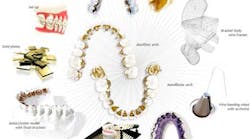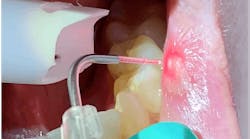Incognito customized orthodontic appliance: a giant leap forward in orthodontic technology
There are several new lingual appliances on the market in 2012. Our office has been using the Incognito™ Appliance System (3M Unitek) over the past four years. The most important part of the system for me is the ability to treatment plan with the finished occlusion first. Considering the pretreatment records, the orthodontist has the ability to dictate to the Incognito laboratory team how the teeth will move. The laboratory team uses the orthodontist’s treatment plan to create a final occlusion that is mounted on an articulator. This articulated setup is the foundation for the customized brackets and wires. Incorporating the final occlusion into the setup allows the orthodontist to plan the appropriate tooth movements. As of May 2012, Incognito has created a digital workflow through its Unitek™ Treatment Management Portal (TMP), which allows for full three-dimensional control over the setup and increases the level of control that the orthodontist and laboratory have over the entire treatment. The Unitek TMP portal allows the orthodontist to treatment plan in 3-D and fully customize the final occlusion with the laboratory team, while both the lab and the orthodontist view the same three-dimensional model. Once the orthodontist agrees on the final occlusion, the Incognito appliance is reverse-engineered to move the teeth from their original malocclusion to their final post-treatment position. Each individual bracket is custom made through CAD/CAM technology for each individual patient. An indirect bonding tray is fabricated from the CAD/CAM system that transfers the individualized custom bracket from the computer to the patient’s mouth. That is only 50% of the technology. The other 50% is the creation of customized wires for each patient. The wires are custom bent through robotics. A robot is able to heat-treat the shape-memory alloy (copper NiTi) wires into a custom arch form and position for each individual tooth. The wire technology allows the orthodontist to use very light forces with small diameter copper NiTi wires all the way through to their stainless steel working wires and finally into a finishing wire that is prebent into the customized brackets for the patient. Because both the wires and the brackets are individually manufactured for each patient, tooth movements are very predictable and eliminate the most difficult part of conventional lingual appliances — the orthodontic finishing of each individual case.Click here to watch a video. At the heart of the Incognito system is treatment planning. Because the system incorporates the final occlusion into the computerized process, it allows the orthodontist to incorporate all of the finishing details into the occlusion from the beginning. Incognito has an advantage over other “invisible” orthodontic appliances for several reasons. Due to its core brackets and wires, all tooth movements can be accomplished. It is a lingual appliance; therefore, it does not suffer from any visible issues that are imposed by conventional ceramic brackets, coated or even translucent wires, and aligner attachments. With the arrival of the Unitek TMP computerized portal, Incognito is a major improvement over lingual appliances of the past and a giant leap forward in orthodontic technology.Author bio Zackary T. Faber, DDS, MS, followed his father, Dr. Richard Faber, and grandfather, Dr. Albert Reitman, to the Baltimore College of Dental Surgery at the University of Maryland. He completed his orthodontic training at the University of Connecticut. Dr. Faber is an active member and founder of several study clubs across Long Island that collaborate across dental specialties. As an assistant clinical professor, he teaches orthodontic residents at SUNY Stony Brook School of Dental Medicine and volunteers at the Dentofacial Deformities Clinic and the Pediatric Residency Program at Cohen's Children's Hospital. Dr. Faber maintains a private practice in Melville, N.Y. You may contact him at [email protected] or at www.faberortho.com.







